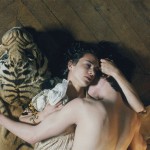By the midpoint of Une vieille maitresse I already knew that Catherine Breillat would be my next project. I’ve always been a bit intimidated by her reputation, I think, which is why I chose this film to be my introduction to her work. A period piece reputed to be relatively tame by Breillat’s standards, Une vieille maitresse proved to be one of my great surprises at the festival. The film is built around a classic love triangle. The rakish Ryno de Marigny is soon to wed Hermangarde, a precious young aristocrat, and, so, has agreed to abandon his ten-year affair with Vellini, a stereotypically hot-blooded, dark-haired Spaniard. In this battle between a Man, his Madonna, and his Whore (and the archetypes were surely part of the appeal for Breillat), there’s a kind of dialectic created between the public sphere of mannered, polite society and the private places where desire and emotion are freed. Much of the film’s action occurs in a flashback, as Marigny recounts his relationship with Vellini to Hermangarde’s grandmother, a disarmingly frank “18th century woman” (as she describes herself) who acts as his confessor. The posh parlor where Marigny tells his tale exists somewhere between the two spheres of conflict, and Breillat seems as interested in the seductions that occur there as she does with anything that happens in Marigny’s bedroom.
Which isn’t to say that the goings-on between the rake and his women are anything less than fascinating. Une vieille maitresse features a show-stopper of a sex scene, a verbal and physical battle between Marigny and Vellini that leaves them both exhausted and satisfied — temporarily, at least. Mid-coitus, Vellini begins to tease Marigny about his most recent lover, a woman he admits is bumbling and cold in the bedroom. The power struggle between them is brilliant to watch, as each tests and transgresses the other’s limits. It probably goes without saying that Asia Argento steals every scene, but Breillat’s staging of their bodies, more than anything else, is what has provoked my curiosity about her work.
Redacted. In March 2006, a small band of American soldiers raped a 14-year-old Iraqi girl then murdered the child and her family in order to cover up their crime. If you’re imagination is so withered that, after reading that sentence, you’re unable to extrapolate from it the many and various tragedies it contains, maybe you should go see Redacted. Brian De Palma seems to think it will help. (If irony and righteous anger are good enough for De Palma, they’re good enough for me.)
Dans la ville de Sylvie* opens with a long, static medium shot of the film’s nameless protagonist sitting alone on his bed, staring intently into the distance. By the end of the seventh day of TIFF, I’d become accustomed to shots like this. The long, static take has come to define an aesthetic that’s en vogue at international festivals these days. (I wonder if it isn’t becoming a new “Tradition of Quality,” in fact.) But there was something slightly different about this particular image, because the character was clearly thinking intently as well. Rather than being a purely formal experience, another moment of cinematic contemplation, this was also narrative. And, sure enough, after several minutes of staring silently, the protagonist (director Jose Luis Guerin calls him “the dreamer”) completes his thought, takes up his pencil, and scribbles into his notebook. He’s a poet and artist, we learn, and he’s recently arrived in Strasbourg, the French town where, six years earlier, he’d met a young student named Sylvie.
I knew I’d found my favorite film of the festival when, two or three minutes into an early sequence at a streetside cafe, it became apparent that we wouldn’t be leaving anytime soon. Guerin was having too much fun with that old cinematic war horse, the Kuleshov Effect, forcing his audience into the perspective of “the dreamer” and, in the process, making one of those films sure to pique the curiosity (and possibly the outrage) of the Mulveyites: a film about men looking at women. It sounds so simple (and simple-minded, even) now that I’ve described Sylvie, but the film is so perfectly executed that, even on a second viewing, I found myself completely seduced by it. And I use the word “seduced” quite deliberately. There’s no denying the male, heteronormative gaze adopted by Guerin’s camera, and I worry that I’m too quick to defend a film that has given me only what the cinema always gives me: free license to oggle women. But something curious happens over the course of Sylvie. By the final sequence, which echoes the earlier cafe scene, we’ve been retrained in a new way of looking. Perhaps I should only speak for myself here, but I felt my gaze become desexualized. The women who walk into and out of “the dreamer’s” frame are no longer just obscure objects of desire. Instead, each takes on that same strange character we find in Tarkovsky’s heroines. I usually name the shot of Margarita Terekhova sitting on the fence in Mirror as my all-time favorite movie image, and the last ten minutes of Sylvie plays like an avant-garde remix of it.
* a.k.a. En la Ciudad de Sylvia or In the City of Sylvia. Why her name changes from Sylvie to Sylvia I don’t know, because it’s definitely Sylvie in the film.

